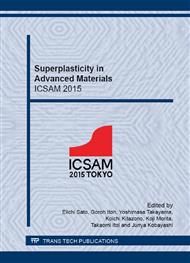[1]
N. Chandra, S.C. Rama, and Z. Chen, Critical Issues in the Industrial Application of SPF-Process Modeling and Design Practices, Mater. Trans., JIM 40(8) (1999) 723-736.
DOI: 10.2320/matertrans1989.40.723
Google Scholar
[2]
F.S. Jarrar, L.G. Hector, Jr., M.K. Khraisheh, and K. Deshpande, Gas Pressure Profile Prediction from Variable Strain Rate Deformation Paths in AA5083 Bulge Forming, J. Mater. Eng. Perform. 21(11) (2012) 2263–2273.
DOI: 10.1007/s11665-012-0196-1
Google Scholar
[3]
E.M. Taleff, L.G. Hector, Jr., R. Verma, P.E. Krajewski, and J. Chang, Material Models for Simulation of Superplastic Mg Alloy Sheet Forming, J. Mater. Eng. Perform. 19(4) (2010) 488–494.
DOI: 10.1007/s11665-010-9612-6
Google Scholar
[4]
J. Kappes, J., M. Liewald, Evaluation of Pneumatic Bulge Test Experiments and Corresponding Numerical Forming Simulations, Journal of Materials Science and Engineering B 1 (2011) 472-478.
DOI: 10.17265/2161-6221/2011.09.011
Google Scholar
[5]
F., Jarrar, M., Liewald, P., Schmid, and A. Fortanier, Superplastic forming of triangular channels with sharp radii. J. Mater. Eng. Perform. 23(4) (2014) 1313-1320.
DOI: 10.1007/s11665-014-0878-y
Google Scholar
[6]
P.E. Krajewski, G.P. Montgomery, Mechanical Behavior and Modeling of AA5083 at 450 oC, in: E.M. Taleff, P.A. Friedman, P.E. Krajewski, R.S. Mishra, J.G. Schroth (Eds. ), Advances in Superplasticity and Superplastic Forming, The Minerals, Metals & Materials Society (TMS), Charlotte, North Carolina, USA, 2004, p.341.
Google Scholar
[7]
F.U. Enikeev, A.A. Kruglov, An analysis of the superplastic forming of a thin circular diaphragm, Int. J. of Mech. Sci. 37(5) (1995) 473-483.
DOI: 10.1016/0020-7403(94)00081-t
Google Scholar
[8]
R. Jovane, An approximate analysis of the superplastic forming of a thin circular diaphragm: theory and experiments, Int. J. of Mech. Sci. 10 (1968) 408-427.
DOI: 10.1016/0020-7403(68)90005-2
Google Scholar
[9]
A. Dutta, A. K. Mukherjee, Superplastic forming: an analytical approach, Journal of Materials Science and Engineering A 157 (1992) 9-13.
Google Scholar
[10]
J.R. Bradley, Bulge Testing of Superplastic AA5083 Aluminum Sheet, in: E.M. Taleff, P.A. Friedman, P.E. Krajewski, R.S. Mishra, J.G. Schroth (Eds. ), Advances in Superplasticity and Superplastic Forming, The Minerals, Metals & Materials Society (TMS), Charlotte, North Carolina, USA, 2004, p.109.
Google Scholar
[11]
F.S. Jarrar, F.K. Abu-Farha, L.G. Hector Jr., M.K. Khraisheh, Simulation of high temperature AA5083 bulge forming with hardening/softening material model, J. Mater. Eng. Perform. 18 (7) (2009) 863–870.
DOI: 10.1007/s11665-008-9322-5
Google Scholar


